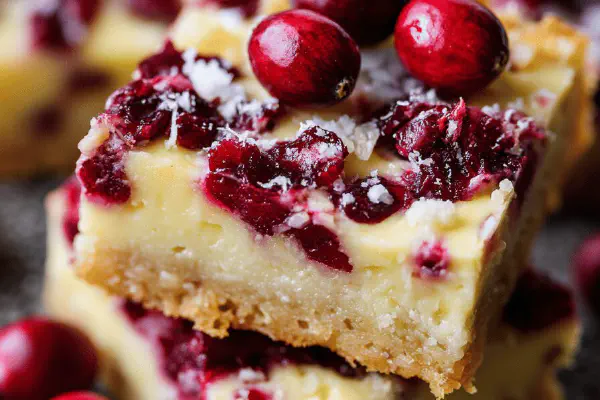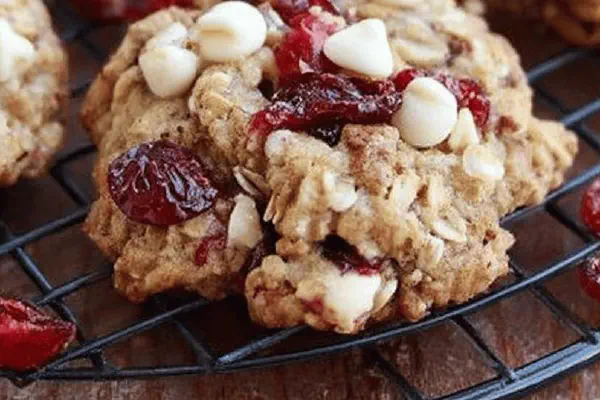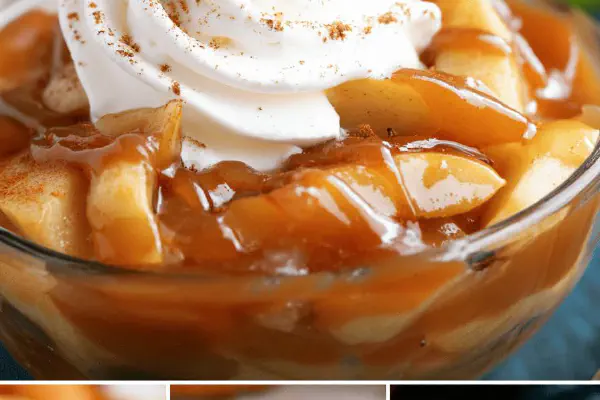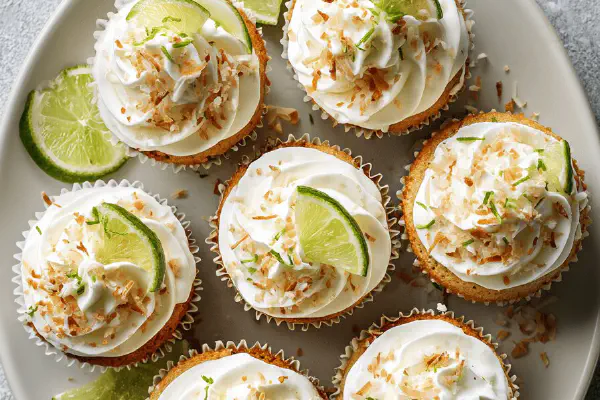Tart Lime Cranberry Bars

E
By Emma
Certified Culinary Professional
•
Recipe tested & approved
Baked bars with a buttery crust featuring chopped dried cranberries and a tangy lime curd filling. The crust balances softness and crispness, with a hint of vanilla. Lime curd cooks slowly thickening over gentle heat, enriched with cream and whole eggs, delivering vibrant citrus notes. Chopped cranberries add subtle chew and bursts of tartness. Can swap butter for coconut oil, and cane sugar for brown sugar for caramel hints. Cool bars fully before slicing for clean edges. Store chilled. Ideal for when craving bright, zesty sweets that aren’t candy-sweet or heavy.
Prep:
25 min
Cook:
38 min
Total:
Servings:
12 servings
#dessert
#baking
#fruit bars
#lime
#cranberry
#easy baking
#North American Fusion
Hungry for something zingy, not overly sweet? Bars are an underrated route — easy to nail once you learn the cues. First time burnt the curd—too quick on heat, suddenly scrambled eggs, chalky mess. Now, low and slow, whisking like mad. The crust needs patience too. Not just a base but a flavor carrier; you want soft chew but also that gentle snap when slicing. Brown sugar switched in here ‘cause pastes with vanilla better in crust than plain white. Cranberries chopped smaller—more burst, less chew-chunk. Citrus twist? Tried lemon but orange zest with lime juice hits bright but round — better balance. Whole eggs in curd bring body; whites alone too flimsy. Heavy cream adds silk, crucial; skip it and curd is thin, never sets. Watching the curd bubble slowly, smelling it thicken — that’s when patience pays. Slap in fridge, preferably overnight. Cuts clean, doesn’t stick like a glue trap on first try. Best chilled, no sogginess if sprung from pan smartly with parchment hooks. Bars store well, no sog or stale crust. Perfect to stash for unexpected guest or quick dessert fix.
Ingredients
CRUST
- 160 g (1 1/4 cup) all-purpose unbleached flour
- 2 ml (1/3 tsp) fine sea salt
- 85 g (6 tbsp) unsalted butter, softened
- 60 g (1/4 cup) light brown sugar, packed
- 2.5 ml (1/2 tsp) vanilla extract
- 1 large egg
- 30 g (3 tbsp) chopped dried cranberries
LIME CURD
- 85 g (1/3 cup) granulated sugar
- 45 g (3 tbsp) unsalted butter, melted
- 3 large eggs
- 1 large orange, zested finely
- 90 ml (6 tbsp) fresh lime juice
- 45 ml (3 tbsp) 35% heavy cream
About the ingredients
Switched flour down slightly for tender crust, reducing dryness risk. Salt a pinch less than usual for rounder sweetness; too much kills subtle citrus notes. Brown sugar chosen over white — deeper flavor but lighter quantity or crust turns soft like cake. Butter at room temp but not melted is key; melted makes crust oily and hardens unevenly. Cranberries chopped small for texture balance; whole bites distract from smooth lime filling. Lime mostly from juice, fresh always — bottled tastes harsh and ruins balance. Orange zest swapped in for lime zest to soften sharp edges from straight lime. Heavy cream added for richness and better curd set; skips mean runny bars. Fat+acid combo stabilizes eggs—curd too custardy without. Eggs fresh, room temp essential; cold eggs scrap juice from mixing effectively, risk lumps. If craving nutty twist, pine nuts toasted into crust is fun alternative, but not here—recipe nut-free for allergy ease. Substitute butter with coconut oil if dairy-free, but note crust flavor changes subtlety. Sugar can be swapped maple syrup/honey but adjust liquid balance, unpredictable texture. Overall, ingredient choices driven by experience aiming for balance, texture, and restraint.
Method
CRUST
- Preheat oven to 175 °C (350 °F). Center rack. Line 23x18 cm (9x7 inch) square pan with parchment, leaving 2 sides overhanging for easy lifting later.
- Whisk flour and salt in a medium bowl. Cream butter, brown sugar, and vanilla in a large bowl with mixer until pale and fluffy. Add egg. Mix until just combined—overbeating makes crust too tough.
- Fold dry ingredients in by hand with wooden spoon until just combined. Stir in cranberries last, crush a bit with fingers to release flavor.
- Press dough evenly onto pan base with fingers or flat-bottomed cup. Pat firmly for even thickness but not overly compressed; want some flake, not concrete.
- Bake ~28 minutes or until crust edges show light golden tones and surface springs back lightly when pressed. Slight crackling sounds from the oven is good sign.
LIME CURD
- While crust bakes, whisk sugar, melted butter, eggs, orange zest, lime juice, and cream in medium saucepan. Keep low heat on stove—medium-low works. Constantly whisk so curd thickens but doesn't scramble eggs.
- After 7-9 minutes, mixture will coat back of spoon and visibly thicken. You’ll see steam rising, bubbles around edges but don’t let it boil vigorously—burns fast and grainy.
- Carefully pour warm curd over hot crust. Return pan to oven for another 12 to 15 minutes. Top should look set with slight jiggle in middle—looks done but not rubbery. Insert toothpick; should come out mostly clean with slight sticky residue.
- Remove from oven, cool on wire rack until only slightly warm. Cover loosely with foil and refrigerate at least 2 hours, ideally 3 or more—cooling solidifies the curd for neat cutting.
- Use parchment handles to lift from pan. Cut into 12 even bars using sharp knife wiped between cuts to avoid crumb drag.
- Serve chilled or room temperature. Bars keep well covered in fridge up to 4 days. Can freeze wrapped tightly for up to a month; thaw overnight in fridge.
- Common swaps: Cranberries can be replaced with dried cherries or blueberries for different tart notes. Orange zest swaps in for lime zest for milder citrus aroma but keep lime juice for tang.
- If crust seems too dry or cracks during baking, increase butter by 1 tbsp next time or press with wet fingers.
- For quicker method, use mixer paddle at low speed to fold in flour, but hand folding preferred for more tender crust.
Cooking tips
Preheat oven early; crust benefits from even heat. Line pan tight with parchment; spillage later ruins bottom texture. Cream butter and sugar until pale; not just mixed but aerated for crumb lift. Egg added gradually to maintain emulsion; breaks mean greasy crust traps. Flour folded gently—over mixing = tough. Cranberries last to keep texture intact; any moisture off kills crust structure. Press dough evenly but not too firmly—over compacted crust turns rigid, no flake. Early golden on edges is best doneness cue—if crust bakes too long, dry. Lime curd cooked on medium-low, relentless whisking essential, no breaks. If whisk stops, risk clumps or burning. Thickening phase smells citrusy, steam veggies acidic punch. Pour carefully over hot crust—curd cooks further in oven, gently setting. Final bake time flexible; look for just-set jiggly top, toothpick test; no raw egg puddles. Cooling step non-negotiable; rushing slicing ruins bars—gooey, messy. Refrigerate minimum two hours; overnight best for clean cuts. Use sharp knife; wipe occasionally; crumbs ruin edges quickly. Stored bars last in fridge for 3-4 days without crust loss or curd weeping. Freezing works but texture changes slightly—thaw in fridge for best results. Tidbit: Use back of spoon pressure to test crust doneness; resists but not rock solid.
Chef's notes
- 💡 Press dough evenly but not overworked; too firm means dense tough crust, want flaky with subtle snap. Chilled butter soft, not melted builds crumb lift. Brown sugar swapped for caramel hint; white sugar dries crust fast. Cranberries chopped small—whole bites interrupt smooth curd mouthfeel. Oven sounds matter—light crackling signals crust done; too quiet means underbaked, too loud means burnt edges. Patience with folding flour; aggressive mixing kills crumb structure.
- 💡 Lime curd thickening happens slow; whisk constantly or eggs scramble fast. Medium-low heat best; steam rising, bubbles at edges guides heat, not boiling. Thick enough when curd coats back of spoon. Pour gently over hot crust to further set in oven; heat from crust finishes curd cooking. Cool bars fully in fridge minimum 2 hours; cutting hot yields sloppy edges. Use sharp knife, wipe crumbs frequently to avoid ragged slices.
- 💡 Butter can be substituted with coconut oil; expect subtle flavor shift, less dairy tone. Cane sugar swap brown sugar for softer sweetness profile. Orange zest replaces lime zest when sharpness is too much, but keep lime juice for tang balance. If crust cracks or looks dry mid-bake, add 1 tbsp butter next bake or press dough with damp fingers to prevent dryness.
- 💡 When folding flour, use spoon not mixer paddle to maintain tender texture, but quicker to use mixer gently on low if short on time. Parchment lining with two sides overhanging prevents stickiness, easy bar removal. Test crust with back of spoon pressure; should resist but not rock hard. Refrigerate bars covered; can freeze tightly wrapped but expect slight texture change, thaw slow in fridge.
- 💡 Don’t rush cooling step—curd sets as it chills. Bars slice cleaner cold. If edges crumble too much, sharper knife or chilled blade works better. Avoid overheating curd; rubbery top spoils texture. Common swaps: dried cherries or blueberries for cranberries add different tart notes; heavier fruit might wet crust slightly, reduce liquid next time. Patience on whisking curd pays off; breaks mean rebuild effort.
Common questions
How to avoid curd scrambling?
Medium-low heat only. Whisk nonstop, never leave unattended. Stop if mix looks thick. Bubbles at edges are good, full boil no. Pour curd warm not hot or risk cracking crust.
Can I freeze bars?
Yes but texture softens. Wrap tightly in foil then bag. Thaw overnight fridge. Cutting frozen bars risks crumbling. Consume within month for best.
Crust too dry or crumbly?
Press dough gently, not too hard. Add small extra butter next time. Over mixing flour toughens crust. Room temp eggs help emulsify better. Don’t skip vanilla; flavor helps mask dryness.
Best way to store bars?
Cover with foil or airtight container in fridge up to 4 days. Chilled bars slice better. Freeze wrapped if no plan to eat soon, but track thawing times. Avoid moisture exposure; soggy crust kills texture.



